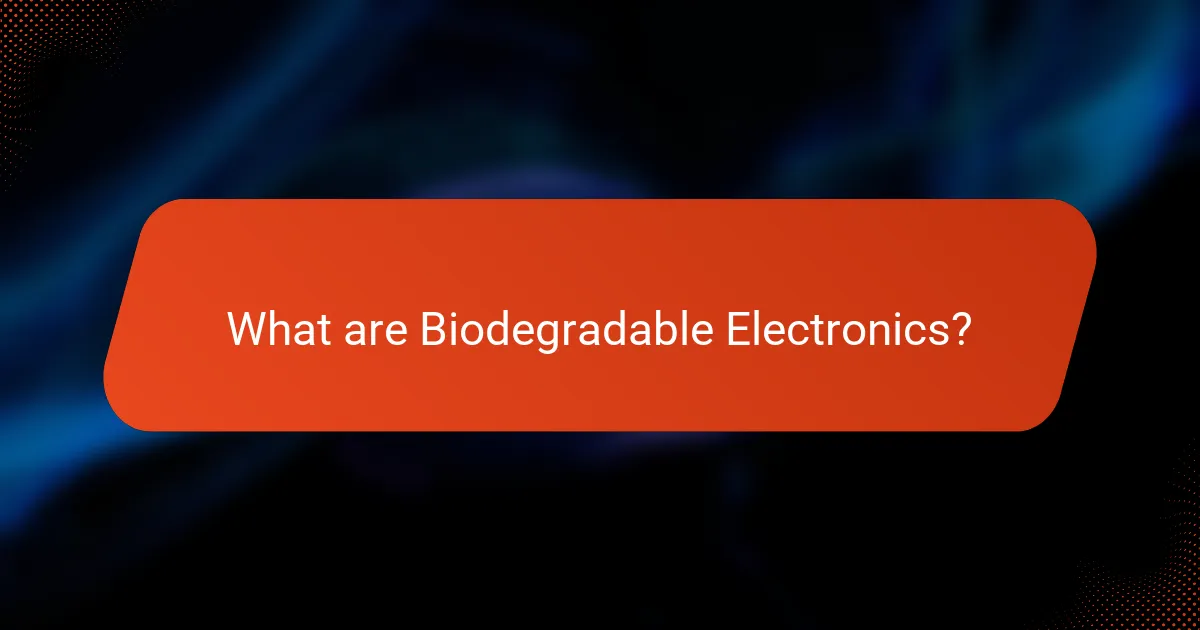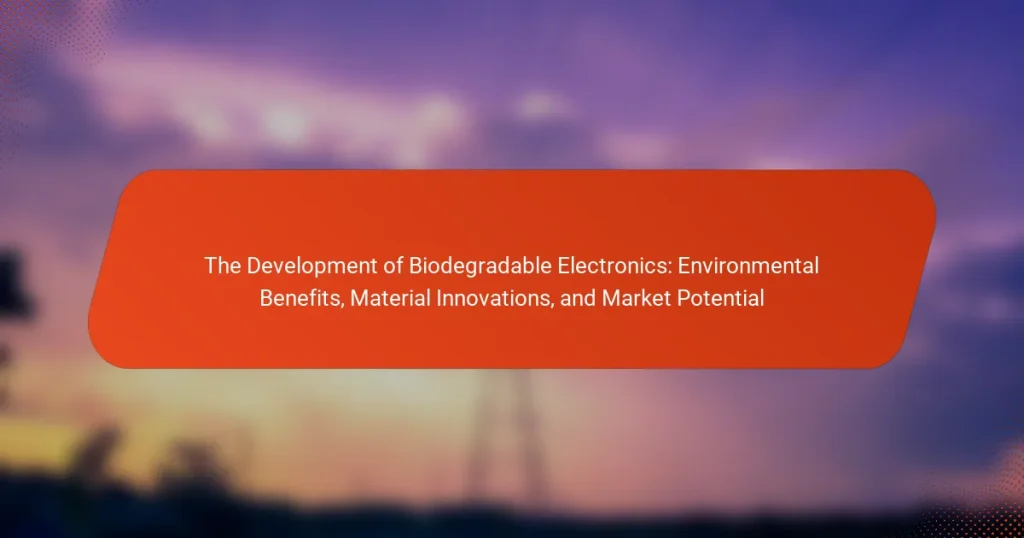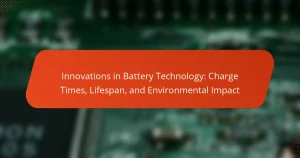Biodegradable electronics are electronic devices engineered to decompose naturally after their functional lifespan, utilizing materials that break down in the environment to reduce electronic waste. This article explores the environmental benefits of biodegradable electronics, highlighting their potential to minimize pollution and their innovative use of polymers and organic materials. It discusses research findings that indicate these devices can disintegrate within months to years, significantly faster than traditional electronics, which can last for decades. Additionally, the article examines the functionality of biodegradable electronics and their importance in advancing sustainable technology solutions, along with their market potential.

What are Biodegradable Electronics?
Biodegradable electronics are electronic devices designed to decompose naturally after their useful life. They utilize materials that can break down in the environment, reducing electronic waste. These devices aim to minimize pollution and environmental impact. Biodegradable electronics are often made from polymers and organic materials. Research indicates that they can disintegrate within a few months to a few years. This is significantly faster than traditional electronics, which can persist for decades. Studies show that biodegradable electronics can maintain functionality while being environmentally friendly. Their development is crucial for sustainable technology solutions.
How do Biodegradable Electronics differ from traditional electronics?
Biodegradable electronics differ from traditional electronics primarily in their material composition. Biodegradable electronics utilize organic materials that decompose naturally over time. Traditional electronics, on the other hand, are made from synthetic materials that persist in the environment for years. The environmental impact of biodegradable electronics is significantly lower due to their ability to break down. Research indicates that these devices can reduce electronic waste and pollution. Studies show that biodegradable components can maintain functionality while being environmentally friendly. This innovation addresses the growing concern of e-waste in landfills. Therefore, biodegradable electronics represent a sustainable alternative to conventional electronic devices.
What materials are commonly used in Biodegradable Electronics?
Common materials used in biodegradable electronics include polylactic acid (PLA), cellulose, and starch-based polymers. PLA is derived from renewable resources like corn starch. Cellulose is a natural polymer found in plant cell walls. Starch-based polymers are also biodegradable and sourced from various plants. These materials are chosen for their environmental compatibility. Research shows that these biodegradable options can reduce electronic waste significantly. Studies indicate that using these materials can lead to a more sustainable electronics industry.
What are the key characteristics of Biodegradable Electronics?
Biodegradable electronics are electronic devices designed to decompose naturally after their useful life. They are made from materials that can break down in the environment, such as biopolymers and organic compounds. These electronics minimize environmental impact by reducing electronic waste. They often feature components that are non-toxic and safe for soil and water. Biodegradable electronics can maintain functionality during their operational lifespan. Research shows that they can degrade within months to a few years, depending on environmental conditions. This characteristic helps address the increasing problem of e-waste globally. Additionally, they are often lightweight and flexible, enhancing their application in various fields.
Why is the development of Biodegradable Electronics important?
The development of biodegradable electronics is important due to its potential to reduce electronic waste. Traditional electronics contribute significantly to global waste, with over 50 million tons generated annually. Biodegradable electronics can decompose naturally, minimizing environmental impact. They can also lessen the demand for raw materials by utilizing sustainable materials. Research shows that integrating biodegradable components can lead to a circular economy in electronics. This innovation supports sustainability goals and aligns with global efforts to combat pollution. Therefore, biodegradable electronics represent a crucial advancement in responsible technology development.
What environmental issues do Biodegradable Electronics address?
Biodegradable electronics address several environmental issues, primarily electronic waste and pollution. Traditional electronics contribute significantly to e-waste, which reached 53.6 million metric tons globally in 2019. E-waste contains hazardous materials that can leach into soil and water, posing health risks. Biodegradable electronics can decompose naturally, reducing landfill contributions. They also minimize the release of toxic substances during disposal. Furthermore, these devices promote resource conservation by utilizing sustainable materials. Studies indicate that biodegradable alternatives can effectively replace conventional components without compromising performance. This shift can lead to a more sustainable electronics industry.
How do Biodegradable Electronics contribute to sustainability?
Biodegradable electronics contribute to sustainability by reducing electronic waste. Traditional electronics often contain toxic materials that persist in landfills. In contrast, biodegradable electronics are designed to decompose naturally. This decomposition minimizes environmental pollution. Studies show that biodegradable materials can break down within months instead of years. This rapid breakdown reduces the accumulation of waste. Additionally, these electronics can be made from renewable resources. Using sustainable materials lowers the carbon footprint associated with production. Overall, biodegradable electronics offer a viable solution to the growing e-waste problem.
What are the potential applications of Biodegradable Electronics?
Biodegradable electronics have several potential applications across various fields. They can be used in medical devices, such as implants and sensors, which can dissolve after fulfilling their purpose. This reduces the need for surgical removal and minimizes waste. In environmental monitoring, biodegradable sensors can track pollutants and degrade after use, leaving no harmful residues. Consumer electronics, like biodegradable phone cases and wearables, can reduce electronic waste significantly. Additionally, they can be utilized in agriculture for smart farming solutions, such as sensors that monitor soil health and decompose after the growing season. These applications highlight the versatility and sustainability of biodegradable electronics in addressing environmental challenges.
Which industries are likely to adopt Biodegradable Electronics?
The industries likely to adopt biodegradable electronics include consumer electronics, packaging, and healthcare. Consumer electronics companies are increasingly focused on sustainability. They seek alternatives to traditional materials that contribute to electronic waste. Packaging industries are adopting biodegradable electronics for more eco-friendly solutions. This shift aligns with consumer demand for sustainable products. Healthcare providers are also exploring biodegradable electronics for medical devices. These devices can reduce environmental impact while maintaining functionality. The automotive industry may adopt these technologies for lightweight components. Overall, the trend towards sustainability drives adoption across various sectors.
How can Biodegradable Electronics impact consumer behavior?
Biodegradable electronics can significantly influence consumer behavior by promoting environmentally responsible purchasing decisions. As awareness of electronic waste grows, consumers are increasingly seeking sustainable alternatives. Biodegradable electronics reduce the environmental impact associated with traditional devices. This shift encourages consumers to prioritize eco-friendly products over conventional options. Research indicates that 66% of global consumers are willing to pay more for sustainable brands. Additionally, brands that adopt biodegradable materials can enhance their market appeal. This appeal is particularly strong among younger consumers who value sustainability. As a result, biodegradable electronics can drive a trend towards greener consumer habits.
What innovations are driving the development of Biodegradable Electronics?
Innovations driving the development of biodegradable electronics include new materials and manufacturing techniques. Researchers are developing polymers that can decompose naturally. These materials often come from renewable sources like plant-based oils. Advances in nanotechnology also play a significant role. They enable the creation of functional electronic components that are both biodegradable and efficient. Additionally, innovations in circuit design are reducing the environmental impact of electronic waste. Studies show that biodegradable electronics can significantly lower pollution levels. The integration of these technologies leads to sustainable alternatives in the electronics industry.
What are the latest advancements in materials for Biodegradable Electronics?
Recent advancements in materials for biodegradable electronics include the development of new polymer composites. These composites utilize natural materials such as cellulose and chitin. Researchers have demonstrated that these polymers can effectively replace conventional electronic materials. Innovations in conductive inks made from organic materials are also notable. These inks maintain electrical conductivity while being environmentally friendly. Another advancement is the integration of biodegradable metals, like magnesium, in electronic components. These metals can dissolve in the environment without leaving harmful residues. Studies indicate that these materials can perform comparably to traditional electronics. Ongoing research focuses on improving the stability and performance of these biodegradable options.
How are researchers improving the functionality of Biodegradable Electronics?
Researchers are improving the functionality of biodegradable electronics by developing new materials and enhancing design techniques. They are focusing on biocompatible polymers and conductive materials that decompose safely. Innovations include integrating natural substances like cellulose and silk for better performance. Researchers are also optimizing the electronic components to ensure they maintain functionality during their lifecycle. Studies show that these advancements can lead to efficient energy storage and improved signal transmission. Recent research published in “Nature Electronics” highlights the successful creation of biodegradable transistors with enhanced durability. These efforts aim to provide sustainable alternatives to traditional electronics while reducing environmental impact.
What challenges do Biodegradable Electronics face in the market?
Biodegradable electronics face significant challenges in the market. One major challenge is the limited availability of suitable materials. Current biodegradable materials may not meet the performance standards of traditional electronics. Additionally, manufacturing processes for biodegradable electronics are often more complex and costly. This complexity can hinder scalability and adoption in mass production. Consumer awareness and acceptance of biodegradable electronics remain low, impacting demand. Regulatory frameworks are still evolving, creating uncertainty for manufacturers. Research and development efforts are required to improve material properties and reduce costs. These challenges must be addressed to enhance the market viability of biodegradable electronics.
What are the limitations of current Biodegradable Electronics technologies?
Current biodegradable electronics technologies face several limitations. One major limitation is their durability. Many biodegradable materials do not withstand environmental stressors as effectively as traditional electronics. This can lead to premature failure of devices. Another limitation is the performance of biodegradable components. They often have lower electrical conductivity compared to conventional materials. This affects overall device efficiency and functionality.
Additionally, scalability is a challenge. Manufacturing processes for biodegradable electronics are not yet optimized for large-scale production. This results in higher costs and limited availability. Furthermore, the degradation rate of these materials can vary significantly. This inconsistency complicates their use in long-term applications. Lastly, regulatory hurdles exist. There is a lack of standardized testing for biodegradable electronics, which can hinder market acceptance.
How can manufacturers overcome obstacles in production?
Manufacturers can overcome obstacles in production by adopting advanced technologies and optimizing processes. Implementing automation can enhance efficiency and reduce human error. Utilizing data analytics allows manufacturers to identify bottlenecks and improve decision-making. Investing in employee training ensures a skilled workforce capable of handling new technologies. Collaborating with suppliers can enhance resource availability and reduce delays. Additionally, conducting regular maintenance on equipment prevents unexpected breakdowns. These strategies are supported by industry reports showing that companies using automation see productivity increases of up to 30%.
What is the future market potential for Biodegradable Electronics?
The future market potential for biodegradable electronics is significant and growing rapidly. The global market is projected to reach approximately $2.5 billion by 2025. This growth is driven by increasing consumer demand for sustainable products. Additionally, regulatory pressures are pushing manufacturers toward eco-friendly alternatives. The rise in electronic waste is also prompting innovation in biodegradable materials. Companies are investing in research and development to create efficient biodegradable components. This trend aligns with global sustainability goals. Overall, the future market potential is promising, with various sectors adopting biodegradable electronics.
What trends are shaping the market for Biodegradable Electronics?
Growing consumer demand for sustainable products is shaping the market for biodegradable electronics. Companies are increasingly focusing on eco-friendly materials to reduce electronic waste. Regulatory pressures are also prompting manufacturers to adopt biodegradable options. Innovations in materials, like bioplastics and organic compounds, are enhancing product performance. Research indicates that the market for biodegradable electronics is projected to grow significantly. This growth is driven by advancements in technology and increased investment in green solutions. Additionally, collaborations between tech firms and environmental organizations are fostering innovation. These trends highlight a shift towards sustainability in the electronics industry.
How can businesses capitalize on the growth of Biodegradable Electronics?
Businesses can capitalize on the growth of biodegradable electronics by investing in sustainable technology development. This involves creating products that minimize environmental impact. Companies can focus on research and innovation to improve biodegradable materials. Collaborating with universities and research institutions can enhance product offerings.
Additionally, businesses should educate consumers on the benefits of biodegradable electronics. Marketing strategies can highlight environmental advantages to attract eco-conscious consumers. Establishing partnerships with eco-friendly brands can expand market reach.
According to a report by MarketsandMarkets, the biodegradable electronics market is projected to grow significantly, indicating strong future demand. This growth presents opportunities for businesses to lead in sustainability.
What best practices should be followed in the development of Biodegradable Electronics?
Best practices in the development of biodegradable electronics include selecting appropriate materials. Materials should be environmentally friendly and capable of decomposing naturally. Utilizing biopolymers like polylactic acid (PLA) is essential. These materials can reduce environmental impact significantly. Additionally, designing for disassembly enhances recyclability. This allows components to be easily separated for reuse or recycling. Implementing life cycle assessments is also crucial. Assessments help evaluate the environmental impact throughout the product’s life. Collaborating with interdisciplinary teams fosters innovation. This can lead to breakthroughs in material science and design. Finally, adhering to regulatory standards ensures safety and efficacy. Compliance with guidelines supports market acceptance and consumer trust.
Biodegradable electronics are innovative electronic devices designed to naturally decompose after their useful life, utilizing materials that minimize environmental impact and reduce electronic waste. This article explores the differences between biodegradable and traditional electronics, the common materials used, key characteristics, and their significance in addressing environmental issues. It also examines potential applications across various industries, market trends, and the challenges faced in production, while highlighting innovations driving the development of these sustainable technologies. The future market potential for biodegradable electronics is promising, driven by consumer demand and regulatory pressures for eco-friendly solutions.




